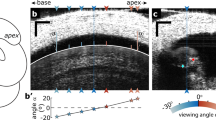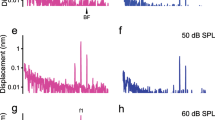Abstract
The hair cell's mechanoreceptive organelle, the hair bundle, is highly sensitive because its transduction channels open over a very narrow range of displacements. The synchronous gating of transduction channels also underlies the active hair-bundle motility that amplifies and tunes responsiveness. The extent to which the gating of independent transduction channels is coordinated depends on how tightly individual stereocilia are constrained to move as a unit. Using dual-beam interferometry in the bullfrog's sacculus, we found that thermal movements of stereocilia located as far apart as a hair bundle's opposite edges showed high coherence and negligible phase lag. Because the mechanical degrees of freedom of stereocilia are strongly constrained, a force applied anywhere in the hair bundle deflects the structure as a unit. This feature assures the concerted gating of transduction channels that maximizes the sensitivity of mechanoelectrical transduction and enhances the hair bundle's capacity to amplify its inputs.
This is a preview of subscription content, access via your institution
Access options
Subscribe to this journal
Receive 12 print issues and online access
$209.00 per year
only $17.42 per issue
Buy this article
- Purchase on Springer Link
- Instant access to full article PDF
Prices may be subject to local taxes which are calculated during checkout






Similar content being viewed by others
References
Hudspeth, A.J., Choe, Y., Mehta, A.D. & Martin, P. Putting ion channels to work: mechanoelectrical transduction, adaptation, and amplification by hair cells. Proc. Natl. Acad. Sci. USA 97, 11765–11772 (2000).
Fettiplace, R. Active hair bundle movements in auditory hair cells. J. Physiol. (Lond.) 576, 29–36 (2006).
Marquis, R.E. & Hudspeth, A.J. Effects of extracellular Ca2+ concentration on hair-bundle stiffness and gating-spring integrity in hair cells. Proc. Natl. Acad. Sci. USA 94, 11923–11928 (1997).
Howard, J. & Hudspeth, A.J. Compliance of the hair bundle associated with gating of mechanoelectrical transduction channels in the bullfrog's saccular hair cell. Neuron 1, 189–199 (1988).
Martin, P., Mehta, A.D. & Hudspeth, A.J. Negative hair-bundle stiffness betrays a mechanism for mechanical amplification by the hair cell. Proc. Natl. Acad. Sci. USA 97, 12026–12031 (2000).
Silber, J., Cotton, J., Nam, J.H., Peterson, E.H. & Grant, W. Computational models of hair cell bundle mechanics: III. 3–D utricular bundles. Hear. Res. 197, 112–130 (2004).
Nam, J.H., Cotton, J.R., Peterson, E.H. & Grant, W. Mechanical properties and consequences of stereocilia and extracellular links in vestibular hair bundles. Biophys. J. 90, 2786–2795 (2006).
Hudspeth, A.J. & Corey, D.P. Sensitivity, polarity, and conductance change in the response of vertebrate hair cells to controlled mechanical stimuli. Proc. Natl. Acad. Sci. USA 74, 2407–2411 (1977).
Crawford, A.C., Evans, M.G. & Fettiplace, R. Activation and adaptation of transducer currents in turtle hair cells. J. Physiol. (Lond.) 419, 405–434 (1989).
Karavitaki, K.D. & Corey, D.P. Hair bundle mechanics at high frequencies: a test of series or parallel transduction. In Auditory Mechanisms: Processes and Models (ed. Nuttall, A.L., Ren, T., Gillespie, P., Grosh, K. & de Boer, E.) 286–291 (World Scientific, Singapore, 2006).
Denk, W., Webb, W.W. & Hudspeth, A.J. Mechanical properties of sensory hair bundles are reflected in their Brownian motion measured with a laser differential interferometer. Proc. Natl. Acad. Sci. USA 86, 5371–5375 (1989).
Martin, P., Bozovic, D., Choe, Y. & Hudspeth, A.J. Spontaneous oscillation by hair bundles of the bullfrog's sacculus. J. Neurosci. 23, 4533–4548 (2003).
Nowak, M., Vaughan, B.A., Wilms, J., Dove, J.B. & Begelman, M.C. Rossi X-Ray Timing Explorer observation of Cygnus X–1. II. Timing analysis. Astrophys. J. 510, 874–891 (1999).
Assad, J.A., Shepherd, G.M. & Corey, D.P. Tip-link integrity and mechanical transduction in vertebrate hair cells. Neuron 7, 985–994 (1991).
Bashtanov, M.E., Goodyear, R.J., Richardson, G.P. & Russell, I.J. The mechanical properties of chick (Gallus domesticus) sensory hair bundles: relative contributions of structures sensitive to calcium chelation and subtilisin treatment. J. Physiol. (Lond.) 559, 287–299 (2004).
Iwasa, K.H. & Ehrenstein, G. Cooperative interaction as the physical basis of the negative stiffness in hair cell stereocilia. J. Acoust. Soc. Am. 111, 2208–2212 (2002).
Henderson, S., Mitchell, S. & Bartlett, P. Propagation of hydrodynamic interactions in colloidal suspensions. Phys. Rev. Lett. 88, 088302 (2002).
Hudspeth, A.J. Mechanoelectrical transduction by hair cells in the acousticolateralis sensory system. Annu. Rev. Neurosci. 6, 187–215 (1983).
Jacobs, R.A. & Hudspeth, A.J. Ultrastructural correlates of mechanoelectrical transduction in hair cells of the bullfrog's internal ear. Cold Spring Harb. Symp. Quant. Biol. 55, 547–561 (1990).
Denk, W. & Webb, W.W. Optical measurement of picometer displacement of transparent microscopic objects. Appl. Opt. 29, 2382–2391 (1990).
Denk, W. & Webb, W.W. Forward and reverse transduction at the limit of sensitivity studied by correlating electrical and mechanical fluctuations in frog saccular hair cells. Hear. Res. 60, 89–102 (1992).
Denk, W., Keolian, R.M. & Webb, W.W. Mechanical response of frog saccular hair bundles to the aminoglycoside block of mechanoelectrical transduction. J. Neurophysiol. 68, 927–932 (1992).
Acknowledgements
The authors thank A.J. Hinterwirth for assistance in constructing the interferometer, B. Fabella for programming the experimental software and O. Ahmad, M.O. Magnasco, K. Purpura and J. Victor for useful discussions. The members of our research group provided helpful comments on the manuscript. The research reported in this paper was funded by the US National Institutes of Health. T.R. was supported by funding from the F.M. Kirby Foundation and from the US National Institutes of Health. A.S.K. was supported by Howard Hughes Medical Institute, of which A.J.H. is an Investigator.
Author information
Authors and Affiliations
Contributions
A.J.H. conceived the experiments, A.S.K. performed them and T.R. conducted the data analysis. A.S.K., T.R. and A.J.H. wrote the paper.
Corresponding author
Ethics declarations
Competing interests
The authors declare no competing financial interests.
Rights and permissions
About this article
Cite this article
Kozlov, A., Risler, T. & Hudspeth, A. Coherent motion of stereocilia assures the concerted gating of hair-cell transduction channels. Nat Neurosci 10, 87–92 (2007). https://doi.org/10.1038/nn1818
Received:
Accepted:
Published:
Issue Date:
DOI: https://doi.org/10.1038/nn1818
This article is cited by
-
In situ motions of individual inner-hair-cell stereocilia from stapes stimulation in adult mice
Communications Biology (2021)
-
PKHD1L1 is a coat protein of hair-cell stereocilia and is required for normal hearing
Nature Communications (2019)
-
Mechanics to pre-process information for the fine tuning of mechanoreceptors
Journal of Comparative Physiology A (2019)
-
Crista egregia: a geometrical model of the crista ampullaris, a sensory surface that detects head rotations
Biological Cybernetics (2015)
-
Forces between clustered stereocilia minimize friction in the ear on a subnanometre scale
Nature (2011)



